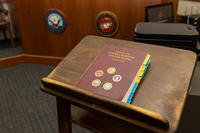The Army's Chief of Staff, Gen. Ray Odierno, and the other service chiefs were kept out of the loop on the Guantanamo prisoner swap for Army Sgt. Bowe Bergdahl but supported the deal after the fact, according to letters released by the office of Sen. Carl Levin, D-Michigan.
"I was not consulted in any way, either in my role as Chief of Staff of the Army or as a member of the Joint Chiefs, prior to the decision to release Sgt. Bergdahl," Odierno wrote in a July 9 letter to Levin, chairman of the Senate Armed Services Committee.
Odierno said the release of a captive U.S. service member "regardless of the circumstances is both a moral imperative and vital to keeping faith within our Army."
As chief military adviser to President Obama, Gen. Martin Dempsey, chairman of the Joint Chiefs of Staff, was included in the top-level discussions on the Bergdahl swap and supported the move.
In his letter to Levin, Dempsey wrote that "I balanced the risk of transferring the detainees with the importance of returning a U.S. soldier from captivity. I concluded the risk posed by the detainees' future activity would be less grave than breaking faith with our forces in combat."
In his own letter supporting the trade, Navy Adm. James Winnefeld , the vice chairman of the Joint Chiefs of Staff, disputed critics of the exchange who argued that the five Taliban prisoners released from the Guantanamo Naval Base would eventually give valuable support to the insurgency.
"While the five detainees are indeed hard-core Taliban, they never posed a direct threat to the United States homeland or our interests outside Afghanistan," Winnefeld said. "I do not consider any of them to be 'game changers' in being able to substantially alter the military situation."
Winnefeld also defended the Obama administration's concerns that a deal had to be concluded rapidly because Bergdahl's health might be at risk.
"We were genuinely worried about Sgt. Bergdahl's health," Winnefeld said, but "we were looking through a glass darkly."
Bergdahl's last 'proof-of-life' video was taken several months before his release, and CIA doctors had concluded from the video that his health might be deteriorating, Winnefeld said.
"Six months later, we simply had no idea whether his health had further declined, leveled off or improved," Winnefeld said. "We had to assume the worst."
In addition to Odierno and Winnefeld, Levin had asked for the opinions on the prisoner exchange of Gen. Martin Dempsey, the chairman of the Joint Chiefs of Staff; Adm. Jonathan Greenert, the Chief of Naval Operations; Gen. Mark A. Welsh III, the Air Force Chief of Staff; Gen. James Amos, the Marine Commandant; and Gen. Frank J. Grass, Chief of the Army National Guard Bureau.
"Each of these military leaders emphasized a simple principle -- America does not leave its troops behind," Levin said.
The high-level discussions prior to Bergdahl's release were "very closely held," Amos wrote, "and thus I was not consulted beforehand." Amos said he was "confident that the exigency of Sgt. Bergdahl's release was balanced against an assessment of the dangers posed by the release of the Taliban detainees."
Since his May 31 release, Bergdahl's care has been carefully monitored by military medical and psychological personnel, first in Germany and since June 13 at Joint Base San Antonio-Fort Sam Houston.
Bergdahl went missing on June 30, 2009, in Afghanistan's Paktika province. An initial Army fact-finding investigation concluded that he left his unit voluntarily while deployed with the 1st Battalion,
501st Infantry Regiment, 4th Brigade Combat Team, 25th Infantry Division.
-- Richard Sisk can be reached at richard.sisk@monster.com




















